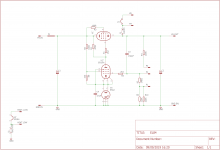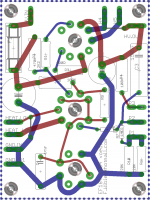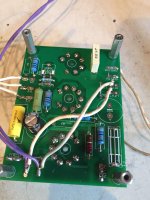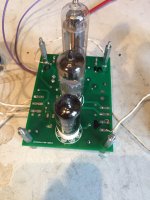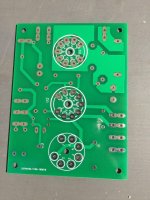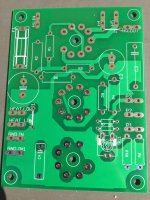Heres a board if you need to regulate screen grids, it runs EL84/86 or PL84 (16V heater EL86) EF184 for control. Reference can be 5651 or 85A2 for stability or 0A2 0B2 if you can only find those, but you have to take care of the minimum reference current in part in the resistive divider for the G2
Cheers,
Cheers,
Attachments
Thats awesome..... in this design the tube will need to burden some 50-70V to archive good regulation....but it will do for screen regulation with good results I have used the same design using 6j9p and Ob2 it is a flexible topology just my 2 cents 

This was a KISS design, i know of a way to get 5..10X more gain out of the error amplifier. Its called Cascode CCS for the anode load. That way you could very easily get 0.5mV of noise plus hum out with about 10VRMS input noise using the EL84 as a pass element because of its higher Mu than the aforementioned 6C19.
6J9P (=E180F) Lends itself well to cascode CCS loading, but in that application EF184 is better, all through the E180F has a slight edge in Anode dissipation, and inherently slightly higher quality. But the EF184 is secretly also a SQ tube, it just doesn't have the label and gold pins.
Another option is E83F plentiful and cheap sometimes cause everyone assumes its a remote cut-off tube due to its ''83 nomenclature. VERY VERY nice tube
See the attached image for the schematic of a universal control board i made two years back, it uses a PNP transistor, but sadly the 2SA1837 has since gone the way of the dodo. Modern replacement from toshiba is TTA006B (same die, different package) however if SMD is not scary to you the FZT560 in SOT223 is also a good choice.
6J9P (=E180F) Lends itself well to cascode CCS loading, but in that application EF184 is better, all through the E180F has a slight edge in Anode dissipation, and inherently slightly higher quality. But the EF184 is secretly also a SQ tube, it just doesn't have the label and gold pins.
Another option is E83F plentiful and cheap sometimes cause everyone assumes its a remote cut-off tube due to its ''83 nomenclature. VERY VERY nice tube
See the attached image for the schematic of a universal control board i made two years back, it uses a PNP transistor, but sadly the 2SA1837 has since gone the way of the dodo. Modern replacement from toshiba is TTA006B (same die, different package) however if SMD is not scary to you the FZT560 in SOT223 is also a good choice.
Attachments
My head hurt trying to understand all those transistors, but then when I saw it I though well why dont drop a pair of IXTP01N100... but the available voltage to make them work would be marginal and in principle it wouldnt be any better than this.... 😛😛 thats something I will use sometime thanks for the tip
Last edited:
Perhaps they may do 'some' good - they may not nicely share current, but they would likely reduce the current (and hence dissipation) of any one zener compared to just using only one zener. Sometimes it comes down to what parts are readily available.
true, if you have no other option it may help a bit, but serial connection of lower voltage devices would still be the much better way to do it
You might want to put a high value resistor from the screen to ground to "tighten up" the Zener diode voltage a bit, since screen grid current draw is low, and spikes if the plate voltage drops below the screen voltage on loud passages. Be sure the resistor can handle the the large voltage across it, and that it has adequate power rating.
- Home
- Amplifiers
- Tubes / Valves
- Screen grid, zener circuit: any concern?
